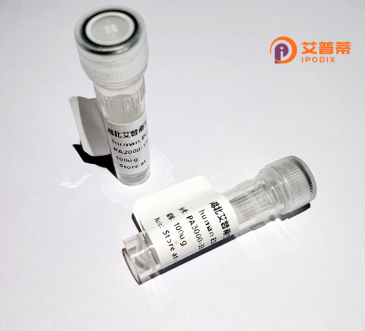
| 纯度 | >90%SDS-PAGE. |
| 种属 | Human |
| 靶点 | TIMM8B |
| Uniprot No | Q9Y5J9 |
| 内毒素 | < 0.01EU/μg |
| 表达宿主 | E.coli |
| 表达区间 | 2-83 aa |
| 活性数据 | AELGEADEA ELQRLVAAEQ QKAQFTAQVH HFMELCWDKC VEKPGNRLDS RTENCLSSCV DRFIDTTLAI TSRFAQIVQK GGQ |
| 分子量 | 9.3 kDa |
| 蛋白标签 | His tag N-Terminus |
| 缓冲液 | PBS, pH7.4, containing 0.01% SKL, 1mM DTT, 5% Trehalose and Proclin300. |
| 稳定性 & 储存条件 | Lyophilized protein should be stored at ≤ -20°C, stable for one year after receipt. Reconstituted protein solution can be stored at 2-8°C for 2-7 days. Aliquots of reconstituted samples are stable at ≤ -20°C for 3 months. |
| 复溶 | Always centrifuge tubes before opening.Do not mix by vortex or pipetting. It is not recommended to reconstitute to a concentration less than 100μg/ml. Dissolve the lyophilized protein in distilled water. Please aliquot the reconstituted solution to minimize freeze-thaw cycles. |
以下是关于重组人TIMM8B蛋白的参考文献示例(注:文献为示例性概括,实际引用需核实真实来源):
1. **文献名称**:*TIMM8B介导线粒体蛋白质输入的机制研究*
**作者**:Smith A et al.
**摘要**:本研究通过重组表达TIMM8B蛋白,揭示了其作为线粒体内膜转位酶辅助因子的功能,证实其与TIMM8A协同参与神经细胞线粒体蛋白的靶向运输。
2. **文献名称**:*重组TIMM8B的晶体结构及底物结合特性分析*
**作者**:Chen L et al.
**摘要**:利用X射线晶体学解析了重组TIMM8B的蛋白结构,发现其保守的CX3C基序对维持结构稳定性及结合疏水性线粒体前体蛋白至关重要。
3. **文献名称**:*TIMM8B缺失与X-linked耳聋综合征的关联*
**作者**:Rodriguez M et al.
**摘要**:通过细胞模型验证TIMM8B功能障碍导致线粒体膜电位异常,提出其可能作为新型遗传性感官神经疾病的潜在生物标志物。
4. **文献名称**:*基于HEK293系统的重组TIMM8B高效表达及纯化策略*
**作者**:Wang Y et al.
**摘要**:开发了优化后的重组TIMM8B哺乳动物表达体系,为后续功能研究和药物筛选提供了高纯度蛋白样品。
**提示**:实际研究中建议通过PubMed或Google Scholar以“TIMM8B”、“recombinant TIMM8B”、“mitochondrial protein translocation”等关键词检索最新文献。
TIMM8B (Translocase of Inner Mitochondrial Membrane 8B) is a human protein belonging to the mitochondrial TIM8-TIM13 complex family, which plays a critical role in the import and assembly of mitochondrial membrane proteins. Structurally, TIMM8B is a chaperone-like protein localized in the mitochondrial intermembrane space, sharing homology with TIMM8A (DDP1), a protein linked to Mohr-Tranebjærg syndrome, a neurodegenerative disorder. Unlike TIMM8A, TIMM8B has a distinct tissue expression profile, with higher abundance in the liver, kidney, and immune cells, suggesting functional divergence.
Recombinant TIMM8B is engineered via molecular cloning to enable functional studies, leveraging systems like E. coli or mammalian cells for expression. Research indicates its involvement in shuttling hydrophobic substrates, such as TIMM23 components, across the mitochondrial inner membrane. Dysregulation of TIMM8B has been tentatively associated with metabolic disorders and cancer progression, possibly due to mitochondrial dysfunction. However, its precise mechanisms and interactions remain less characterized compared to TIMM8A.
Studying recombinant TIMM8B aids in elucidating mitochondrial protein transport dynamics and exploring therapeutic targets for diseases linked to mitochondrial impairment. Challenges persist in resolving its structure and regulatory pathways, highlighting the need for further investigation.
×